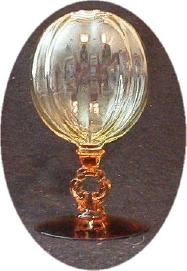Ivy Balls
by George Hoffman
Issue #53 September 1977
An advertisement in the May, 1931 issue of China, Glass and Lamps, pictures an all crystal #1236 footed Ivy Ball. This is the first known reference to this lovely piece of Cambridge glass.
 The 1930-34 Catalog Reprint contains three pictures of this Ivy
Ball. Page 31-8 pictures it in crystal, page 32-9 lists it as a
two-tone "Quick Seller" and page 34-11 shows it in Crown Tuscan.
The 1930-34 Catalog Reprint contains three pictures of this Ivy
Ball. Page 31-8 pictures it in crystal, page 32-9 lists it as a
two-tone "Quick Seller" and page 34-11 shows it in Crown Tuscan.
Ivy Balls greatly enhance the lovely Cambridge color spectrum - either on display or in use. They are most decorative and also practical for use. As their name implies, they were used most often for growing ivy, either in water or dirt. Many of the ones we find today are water stained, or "sick", as many collectors call the unsightly stain. This of course is added testimony to the fact that they were well accepted and used by the housewife of that time.
Ivy balls can be found in many different colors and almost endless decorations. In crystal, they can be found either plain or with an endless array of etchings and rock crystal cuttings. The two-tone effect is found most often, with a crystal stem and foot and the top being in any of the following colors: Carmen, royal blue, dianthus pink, Peach-Blo, light emerald green, forest green, ebony, heatherbloom, gold krystol, willow blue, and moonlight blue. At left is an unusual two-tone ivy ball in yellow and amber.
The foot and top are the same color on the Crown Tuscan ivy balls with a variety of gold encrusted decorations. We know of one with a flashed or sprayed on type finish. Solid color ivy balls, other than Crown Tuscan and crystal, have not been found as of this writing, but they certainly are not beyond the realm of possibility. If anyone has such a piece or has seen one, we certainly would be interested in hearing about it.
Ivy Balls were evidently a popular item as they were in production for many years. The every day use that they were submitted to is probably the reason they are not very plentiful today.
Undoubtedly they were easily knocked over and broken. Since they were not an expensive item (a 1940 Price Guide lists them at $16.50 per dozen), they evidently were not treated with the same Tender Loving Care that their owners shower upon them today.
